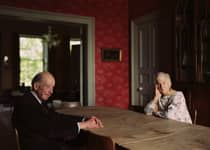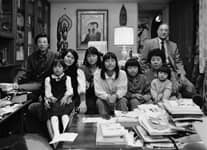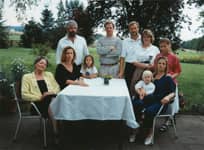Hartmann had seen some of Struth’s Düsseldorf street photographs and in 1982 he suggested they collaborate on a research project. Together they collected family photographs from forty people. Struth then made black-and-white prints, all in the same format and size, so that they could function better as a tool for comparative analysis. They then organised the images into groups based on different categories. “We were hoping to retrieve and present what was legible and understandable, to see what narratives about family life could be reconstructed from this evidence.” Around sixty images were presented as an exhibition called Familienleben at the Deutsche Akademie für Psychoanalyse in Düsseldorf in 1982 and a second time at the Institute’s branch in Freiburg in 1983. The collaboration with Hartmann was considered by both of them as research and Struth has never exhibited this project in an art context.
“The question of the family was precipitated largely through an attempt to analyse and understand my own family, my family’s history and myself within this context. Your own family is not something you have a choice about. The family was a very charged issue in the Germany I grew up in. The question of what your family did under fascism was never far away, why they accepted what was going on, how this affected them in the period of reconstruction and starting a family after the war and how, as a child, you can define a moral position towards the atrocities of the holocaust and the questions you have for your parents.
The making of one of Struth’s family portraits is always informed by the same set of conditions. The initial invitation comes from the artist; the family portraits are, with rare exceptions, not made on commission. The family decides together with Struth the location and framing of the photograph in their home or garden. They organise and pose themselves. They are always asked to look directly into the camera. Struth was initially concerned that the family portraits would be misconstrued as classical and old-fashioned. On the other hand, the connection of his work to common kinds of photography embedded in everyday life has been a continuing interest, and family photography is probably the most common form of all.
A first group of family portraits was exhibited as part of Struth’s exhibition Neue Bilder at Galerie Max Hetzler in Cologne in January 1989. Eleven family portraits were exhibited alongside portraits of individuals and couples in Thomas Struth: Portraits at the Museum Haus Lange in Krefeld in 1992. The family portraits are an ongoing project, developing at its own pace alongside other series of works.



